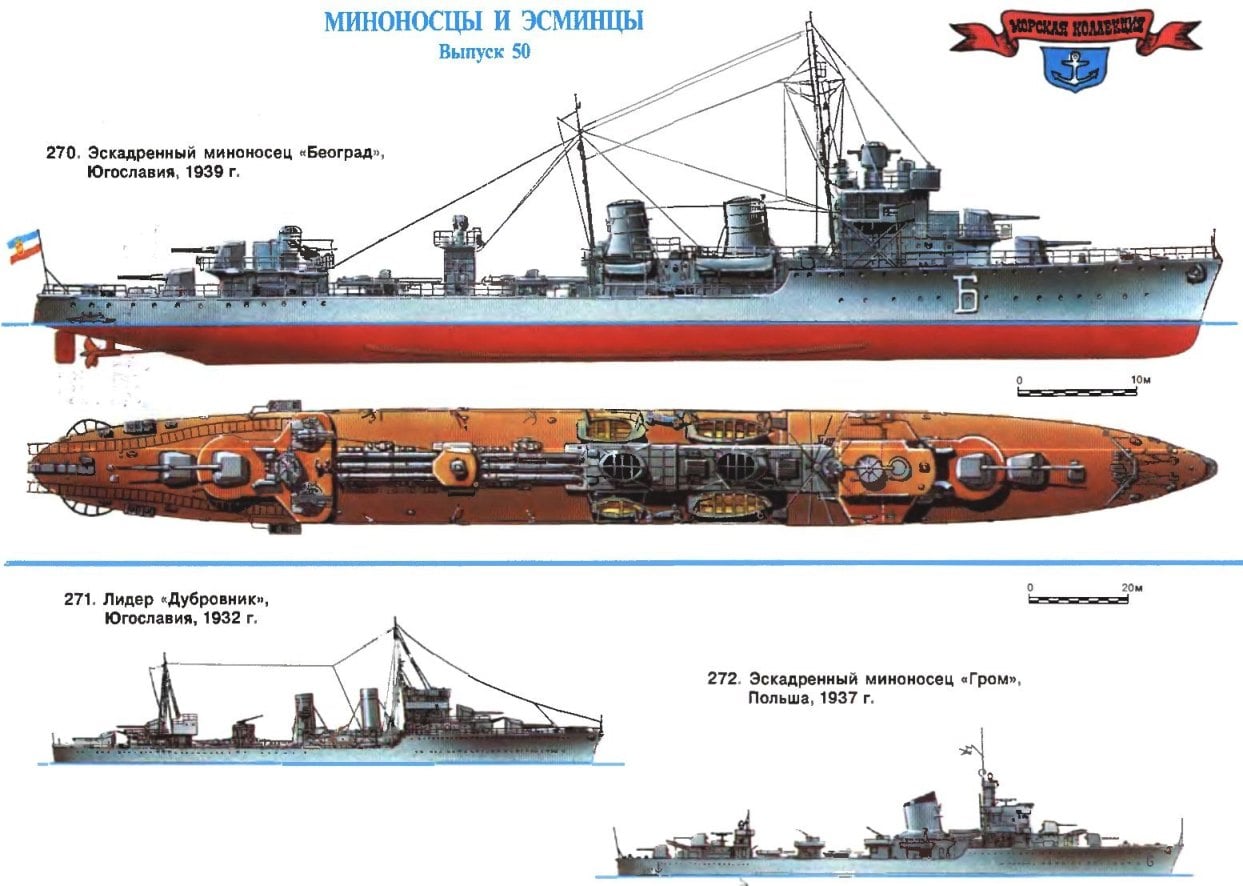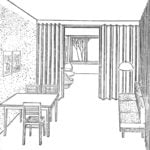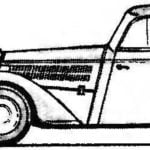 The end of the First world war and the subsequent Washington agreement significantly changed the situation in world shipbuilding. The moratorium on new capital ships led to the fact that in the hierarchy of the military fleets of space battleships in some way took heavy cruisers, and the cruisers — destroyers. This sposobstvoval and objective process of evolution of the torpedo class ships. The destroyers and especially the leaders by the time it is grown — both in size and in a circle of solved tasks — until the armored cruisers of twenty years ago. For many countries in the “second tier” that the destroyers were the biggest and powerful fighting units in their fleets.
The end of the First world war and the subsequent Washington agreement significantly changed the situation in world shipbuilding. The moratorium on new capital ships led to the fact that in the hierarchy of the military fleets of space battleships in some way took heavy cruisers, and the cruisers — destroyers. This sposobstvoval and objective process of evolution of the torpedo class ships. The destroyers and especially the leaders by the time it is grown — both in size and in a circle of solved tasks — until the armored cruisers of twenty years ago. For many countries in the “second tier” that the destroyers were the biggest and powerful fighting units in their fleets.
Of course, the tactical use of torpedo ships admirals minor Maritime powers is seen differently than their colleagues from the UK or, say, USA. About the massed attacks of the enemy squadrons couldn’t be considered. The destroyer is seen as a universal artillery and torpedo craft that can overtake and destroy the weaker enemy, and to leave stronger. This idea was not new, but for many it still looked attractive. And so it is not surprising that the most powerful destroyers destroyers often have a country, whose fleets have traditionally been considered almost in last place…
In the early 20-ies in the English word destroyer appeared two analogue, this time Slavic. Just created independent States of Poland and Yugoslavia (at first it was officially called Kingdom of Serbs, Croats and Slovenes)— undertook the creation of its own naval forces. A special place in their composition was to take the destroyers. The last poles were called “destroyers” (niszczycieli), and Yugoslavs — “the destroyers” (razaraci). And, despite the remoteness of these countries from each other and quite different Maritime theatres, their shipbuilding program intricately intertwined, at least in respect of the destroyers.
The first destroyers to its fleet ordered the government of Poland. Without further ADO, the poles chose the French ships of the type “Barrack” (see “modelist-Konstruktor” No. 3, 2001): for its time, these “topiary” with 130 mm artillery looked almost cruisers. The project has made only minor changes to the French 37-mm anti-aircraft guns replaced the 40 mm Swedish “bothersome”, the deck was equipped with mine rails. But for some reasons (primarily political) entered into a contract with a little-known shipyard in Blanville, not having sufficient experience in construction of ships of this class. As a result, the construction time is greatly delayed. Particularly unlucky destroyers head “Buža” (“Storm”): it was commissioned nearly six years after the laying — in August 1932. Work on the same type of “Vehere” (“Whirlwind”) was able to complete twice as fast, and he was adopted by the Navy two years earlier — in July 1930.

270. Destroyer “Beograd”, Yugoslavia, 1939
Built in France by the company “Atelier e Chantiers de La Loire”. The standard displacement of 1210 tons, full 1655 T. maximum Length 98 m, width of 9.45 m, draft 3,18 m. Capacity twin-shaft steam turbine 40 000 PS, speed 38 knots. Armament: four 120-mm guns, four 40 mm anti-aircraft machine gun, two 15 mm machine gun, two three-pipe 550-mm torpedo tubes. Just built three units: “Beograd”, “Ljubljana” and “Zagreb” (the last two in the shipyard in split, Yugoslavia).
271. The leader of the “Dubrovnik”, Yugoslavia, 1932
Built in England by the firm “yarrow”. Displacement standard full 2884 1880 T. T. maximum Length of 113.2 m, width of 10.66 m, draft 3.6 m, Capacity of two-shaft steam turbine 42000 HP, speed 37 knots. Armament: four 140-mm guns, two 83-mm anti-aircraft guns, six 40 mm anti-aircraft machine gun, two three-pipe 533-mm torpedo tubes.
272. Destroyer Grom, Poland, 1937
Built in England by “white”. The standard displacement of 2144 tons, full-3383 T. maximum Length 114 m, beam 11,3 m, draft 3.1 m. Capacity twin-shaft steam turbine 54 000 HP, speed of 39 knots. Armament: seven 120-mm guns, four 40 mm anti-aircraft gun, eight 13.2-mm machine guns, two traktornyh 533-mm torpedo tubes. Just built two units: “Thunder” and “Blyskawica”.
The rapid progress in the development of class fleet of ships-carriers of torpedoes has led to the fact that designed in the early 20’s “Burrasca”, to claim the title of “superessence”, ten years (that is, at the time of commissioning of their Polish counterparts) looked quite ordinary ships. Therefore, anticipating this, the Yugoslavs went the other way: they decided to create the “destroyer” is obviously more powerful than any that existed at the time of his fellows. Artillery for vehicle offered to put Czechoslovakia, which was considered an important political ally of Belgrade. In addition, the plant “Skoda” was a longtime partner of the Austro-Hungarian Navy, the progenitor of the Yugoslav Navy.
In the competition for the design of the destroyer was attended by several English and French firms, of which made it to the finals of the British “white” and “yarrow”. In the end, Yugoslavia has opted for the latter. In August 1929, there was signed the contract for the construction of the destroyer, named “Dubrovnik”. Thus began the tradition to call the destroyers of the Yugoslav Navy in honor of major cities; previously, such names were supposed to the ships of a rank no lower than cruisers.
The main feature of the “Dubrovnik” — extremely powerful artillery. This ship was the first and only destroyer, armed with a 140 mm “skadovskyi” guns with a barrel length of 56 calibres, capable of firing projectiles with a mass of 39.9 kg to a range of 23.4 km. over the next decade he carried the heavy artillery in their class until the appearance of the German “zerstorer” with a 150-mm guns. Because of this, as well as ie for its status as a flagship of the Yugoslav Navy “Dubrovnik” usually called a leader, even though technically he was listed as “ramarasam” that is, an ordinary destroyer.
Overall, the experts estimated the “Dubrovnik” as a very successful ship. In addition to the powerful artillery he had the perfect power plant that provided on the test course at 40.3 host 3.3 host more than was envisaged under the project. The cruising range was truly a record-breaking 15-node swing the leader could go 7000 miles. This was achieved due to the impressive capacity of the fuel tanks (590 t) and special stuff, the low-speed turbine of economic progress.
Number of samples introduced advanced technology “Dubrovnik” was an example of this “internationalism”: the mechanisms, torpedo tubes and accessories it was English, rangefinders and fire control system — Dutch, communications — Belgian, artillery (including antiaircraft) — Czech. Interestingly, the project leader was supposed to carry a seaplane, but its installation has declined in the stage of construction.
“Dubrovnik” made a strong impression on the naval specialists of different countries. And when the Polish government financed the construction of the next couple of destroyers, their characteristics were chosen with an eye to the Yugoslav “destroyer”. And then podsuetilis the British company “white”, suggesting the poles the same project rejected by Belgrade. After short negotiations the contract for construction of destroyers “Grom” and “Blyskawica” (“Thunder” and “Lightning”) was signed. Two more ships later planned to build a shipyard in Gdynia, but for financial reasons their bookmark has been repeatedly postponed and eventually never took place.

273. Destroyer “Split”, Yugoslavia, 1958
Built in Yugoslavia in the shipyard in split. The standard displacement of 2400 g, 3000 full so maximum Length is 114.8 m, beam of 11.1 m and draught of 3.8 m. Capacity twin-shaft steam turbine 50 000 HP, speed 38 knots. Armament: four 127-mm guns, twelve 40 mm anti-aircraft machine guns, one platetronic 533-mm torpedo tubes. Built one unit.
The dimensions and displacement of Thunder was the biggest destroyer of the British built 30 years — he excelled, and “Dubrovnik”, and build later ships of the type “Tribal”. Main Polish artillery “destroyer” — seven 120-mm guns of the Swedish company “Bofors”, located in four plants. Three of them were paired; the nose in order to prevent the preponderance of a ship on the nose had to do odnorodnoi. These guns with a barrel length of 50 calibers could fire 24-pound shells at a distance of 19.5 km. In General artillery power of the “Thunder” and “Blyskawica” roughly equivalent “tribum”, but, unlike the latter, the “poles” carrying polnotsennoe and torpedo weapons. And the speed they were superior to all their English brethren. Finally, these ships possessed unusual for its time, architecture, becoming the first British destroyers Monotube construction.
The Polish and Yugoslav, superspin-Tzu with all their advantages had one major drawback — they were too expensive and therefore could not be numerous. When the Yugoslavs realized that to deploy serial construction of ships drawings of “Dubrovnik” on their yards they will not succeed, they began to search for a cheaper project. Moreover, as the prototype they chose… all the same “Barrack”, which in my modest for 30 years characteristics attracted by simplicity, reliability and low cost.
Head destroyer of new series, named “Beograd”, were ordered in the firm “Studio e Chantiers de La Loire” in Nantes; the other two — “Ljubljana” and “Zagreb” — was built by the French documentation in the shipyard in split. A draft of these ships was a smaller, but a much improved version of “Burrasca”. Compared with the prototype of the “Beograd” had a number of fundamental differences. First, he, like “Dubrovnik”, had a typically English boiler and turbine installation, delivered by firm “yarrow”. Second, the artillery of destroyer again was a Czech production: 120-mm gun of the company “Skoda” with a barrel length of 46 calibres could shoot a 24-kg shells to a maximum range of 20.8 km. Although it is, of course, was weaker than the main caliber “of Dubrovnik”, the weight of one of the deck installation was only 9 t, compared to 15.6 t on the leader.
Torpedo weapons “Beograd” — typically French, similar to that installed on the “Burrasca”. Curious, though difficult to explain the fact: Yugoslavia and Poland not standardized the caliber of its torpedoes and, with the beginning of the Second world war by four destroyers, had two types of self-propelled min — 533-mm English and 550 mm French.
On sea trials “Beograd” showed the course in 39 nodes per node more than design. Recall that “Barrack” (and “Wiecher” with “Bougie”) could develop only 33 node — in this respect, the replacement of energy for a more modern went clearly in favor. However, the supply of fuel, in comparison with the “Dubrovnik”, had to drastically reduce (up to 120 t), and the cruising range was only 1200 miles. However, for the Adriatic, such a value is considered acceptable.
On the eve of the war, in July 1939, at the shipyard in split, the laying of the last warship of the Royal Yugoslavia. The project, developed jointly with the French, the leader of the “Split” was a long “Dubrovnik” with five 140-mm guns, ten 40-mm guns and two three-pipe torpedo tubes. However, the events that followed upset all plans.
The German attack caught the command of the Polish Navy off guard. On the third day of the war “Junkers” was sunk in Hel “Wiecher”. The three remaining destroyers managed to escape from the Baltic to England and later worked together with the British fleet. Off the coast of Norway on 3 may 1940 killed “Grom” — a direct hit by a German bomb broke the ship in two. In the same month, had almost shared his fate and “Buža”, came under the airstrike in Calais. However, the destroyer managed to rescue and repair, and it is up to the end of the war participated in the Atlantic convoys. Even more were active “Blyskawica”. In December 1941 she was rearmed, coupled with four 102-mm universal artillery systems and several “Arlekino”; later it appeared in modern radars. “Blyskawica” fought in all European theatres, from the Mediterranean to the Arctic. During the allied landing in Normandy, she, along with the English ships involved in the battle, which ended with the destruction of the German destroyers Z-32 and ZH-1.
After the war, the “Buža” and “Blyskawica” for a long time was laid up in England, but then was returned to Poland. Of them “Blyskawica” persists to this day as Museum ships in Gdynia.
The fate of the Yugoslav destroyers was more sad. Belgrade did not manage to remain neutral in the war. In early 1940 the country was hit by a deep political crisis, and soon Croatia declared its independence. Germany, taking advantage of the split in society, invaded Serbia. The fleet was caught between two fires, not knowing what kind of government should obey. In the end, almost all Yugoslav ships without fight handed over to the Italians. Avoided the shameful fate of the destroyer “Zagreb” — it blew up in the officers own crew refused to comply with the order to surrender.
In the Italian Navy “Dubrovnik”, “Beograd” and “Ljubljana” were given new names, respectively “Premuda”, “Sebenico and Lubiana”. They were rearmed and used primarily for the protection of convoys. In April 1943, “Lubiana” was wrecked off the coast of Tunisia. The other two ships in the same year went to the Germans. The new owners re-equipping them, reclassified to destroyers and renamed TA 32 and TA-43. It is noteworthy that the role of the TA-32 ex “Dubrovnik” as the main fire carried only four 105-mm antiaircraft guns, which to some extent justified his new status destroyer. Before the surrender of Germany, both former “Yugoslavia” were sunk by the crews.
The unfinished leader “Split” also fell into the hands of the Italians and then the Germans. At the end of the war, it flooded, but, nevertheless, the Yugoslavs managed to raise his ship. In the end the Split was completed on a completely different project. His artillery armament consisted of four American 127-mm universal guns, American was radar equipment. Did all this “Split” is very similar to a modernized 50 years of the Fletcher. However, by the time of its entry into operation (1958) “Split” is hopelessly outdated and maintenance tools and concepts, so during his short service in the Navy of Yugoslavia, it was used as a training ship.
S. BALAKIN



